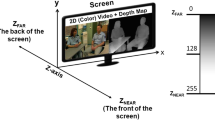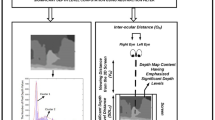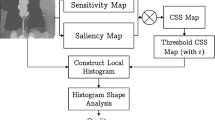Abstract
Recent technological breakthroughs in 3-Dimensional (3D) video capture, display, coding, transmission, rendering, etc. have led the advances of 3D multimedia applications into the consumer market. However, the effect of these technologies on 3D video Quality of Experience (QoE) has not been thoroughly investigated to speed up the wide-spread proliferation of the 3D video applications in this market. Quality and depth perception assessment of 3D video from the view of end users reflects the most important aspect of 3D video QoE. Therefore, evaluating quality and depth perception of 3D video should be given the utmost attention. Currently, the depth perception assessment of 3D video can only be achieved using time consuming and rigorous subjective assessments due to the lack of reliable and efficient objective metrics. Assessing the depth perception using Full-Reference (FR)/Reduced Reference (RR) objective metrics is not efficient for on the fly 3D video applications due to the requirement of original video/extracted information at the receiver side. Thus, a No Reference (NR) metric, which does not need any original video related information at the receiver side to predict the depth perception, is proposed in this paper. Three important cues (i.e., binocular parallax, lateral motion, and aerial perspective) for Human Visual System (HVS) to perceive the depth of a 3D video are utilized to develop the NR metric. Experimental results devised using the proposed metric prove the effectiveness of it to predict the depth perception.




Similar content being viewed by others
References
Albonico A, Valenzise G, Naccari M, Tagliasacchi M, Tubaro S (2009) A Reduced-reference video structural similarity metric based on no-reference estimation of channel-induced distortion. IEEE International Conference on Acoustics, Speech, and Signal Processing, Taipei, Taiwan, 19–24 Apr. 2009
Argyropoulos S, Raake A, Garcia MN, List P (2011) No reference bit stream model for video quality assessment of H.264/AVC video based on packet loss visibility. In: IEEE Int. Conf. on Acoustics, Speech, and Signal Processing (ICASSP)
Argyropoulos S, Raake A, Garcia MN, List P (2011) No-reference video quality assessment for SD and HD H.264/AVC sequences based on continuous estimates of packet loss visibility. IEEE Third International Workshop on Quality of Multimedia Experience (QoMEX), Mechelen, 7–9 September, 2011
Brandao T, Queluz MP (2008) No-reference image quality assessment based on DCT domain statistics. Signal Process 88(4):822–833
Brandao T, Queluz MP (2010) No-reference quality assessment of H.264/AVC encoded video. IEEE Trans Circ Syst Video Technol 20(11):1437–1447
Callet PL, Viard-Gaudin C, Pechard S, Caillaultn E (2006) No reference and reduced reference video quality metrics for end to end QoS monitoring. IEICE Trans Commun E85_B(2):289–296
Cheong LF, Xiang T (2001) Characterizing depth distortion under different genetic motions. Int J Comput Vis 44(3):199–217
Devore JL (2003) Probability and statistics for engineering and the sciences, 6th edn. Duxbury Press, Pacific Grove, CA
Do CB, Batzoglou S (2008) What is the Expectation Maximization algorithm? Nat Biotechnol 26(8):897–899
Donghyun K, Seungchul R, Kwanghoon S (2012) Depth perception and motion cue based 3D video quality assessment. IEEE International Symposium on Broadband Multimedia Systems and Broadcasting(BMSB), 27–29 June 2012
Eden A (2007) No-reference estimation of the coding PSNR for H.264-coded sequences. IEEE Trans Consumer Electronics 53(2):667–674
Farias MCQ, Mitra SK (2005) No reference video quality metric based on artifact measurements. IEEE International Conference on Image Processing, 11–14 September 2005
Gunawan IP, Ghanbari M (2008) Reduced-reference video quality assessment using discriminative local harmonic strength with motion consideration. IEEE Trans Circ Syst Video Technol 18(1):71–83
Hall P, Wand MP (1988) On the minimization of absolute distance in kernel density estimation. Stat Probab Lett 6:311–314
Hansard M, Horaud R (2008) Cyclopean geometry of binocular vision. J Opt Soc Am 25:2357–2369
Harris JM, German KJ (2008) Comparing motion induction in lateral motion and motion in depth. Elsevier Vis Res 48:695–702
Hewage CTER, Martini MG (2010) Reduced-reference quality evaluation for compressed depth maps associated with colour plus depth 3D video. 17th IEEE International Conference on Image Processing, Hong Kong, 26–29 Sep. 2010
Hewage CTER, Worrall ST, Dogan S, Villette S, Kondoz AM (2009) Quality evaluation of color plus depth map-based stereoscopic video. IEEE J Sel Top Signal Proc 3(2):304–318
Hsien K (2005) K Means clustering, nearest cluster and Gaussian mixture. available at: www.docstoc.com/search/k-means-clustering/, Jun. 2005
Huynh-Thu Q, Ghanbari M (2008) Scope of validity of PSNR in image/video quality assessment. IET Electron Lett 44(13):800–801
Huynh-Thu Q, Le Callet P, Barkowsky M (2010) Video quality assessment: from 2D to 3D challenges and future trends. 17th IEEE International Conference on Image Processing, Hong Kong, 26–29 Sep. 2010
ITU-R BT.500–11 (2002) Methodology for the subjective assessment of the quality of television pictures
Jones V (2009) Mean direction and mean absolute deviation. ASTM Standards and Engineering Digital Library
JSVM 9.13.1. CVS Server [Online]. Available Telnet: garcon.ient.rwth aachen.de:/cvs/jvt
Karim HA, Hewage CTER, Worrall S, Kondoz AM (2008) Scalable multiple description video coding for stereoscopic 3D. IEEE Int Conf Consum Electron 54(2):745–752
Keimel C, Klimpke M, Habigt J, Diepold K (2011) No-reference video quality metric for HDTV based on H.264/AVC bit stream features. 18th IEEE International Conference on Image Processing (ICIP), Brussels, Belgium, 11–14 Sept. 2011
Lebreton P, Raake A, Barkowsky M, Le Callet P (2012) Evaluating depth perception of 3D stereoscopic videos. IEEE J Sel Top Signal Proc 6(6):710–720
Lin X, Ma H, Luo L, Chen Y (2012) No-reference video quality assessment in the compressed domain. IEEE Trans Consum Electron 58(2):505–512
Lin X, Tian X, Chen Y (2012) No-reference video quality assessment based on region of interest. International Conference on Consumer Electronics, Communications and Networks (CECNet), Yichang, 21–23 April 2012
Liu Z, Chen T (2009) Distance measurement system based on binocular stereo vision. IEEE International Joint Conference on Artificial Intelligence
Martini MG, Villarini B, Fiorucci F (2012) A reduced-reference perceptual image and video quality metric based on edge preservation. EURASIP J Adv Sig Process (1):1–13
Mittal A, Moorthy AK, Ghosh J, Bovik AC (2011) Algorithm assessment of 3D quality of experience for images and videos. IEEE Digital Signal Processing Workshop, 4–7 Jan. 2011.
Moorthy AK, Bovik AC (2011) Video quality assessment algorithms: what does the future hold? Springer Multimed Tools Appl 51(2):675–696
Naccari M, Tagliasacchi M, Tubaro S (2009) No-reference video quality monitoring for H.264/AVC coded video. IEEE Transactions on Multimedia 11(5):932–946
Narvekar ND, Karam LJ (2009) An Iterative Deblurring algorithm based on the concept of just noticeable blur. International Workshop on Video Processing and Quality Metrics for Consumer Electronics, Jan. 2009
Nian Q (1997) Binocular disparity and the perception of depth. Neuron 18:359–368
Nur G, Bozdagi Akar G, Gokmen H (2012) A reduced reference 3D video quality assessment based on cartoon effect. NEM Summit Conference, Istanbul, Turkey, 16–18 June 2012
Nur G, Kodikara Arachchi H, Dogan S, Kondoz AM (2012) Advanced adaptation techniques for improved video perception. IEEE Trans Circ Syst Video Technol 22(2):225–240
Oelbaum T, Diepold K (2007) Building a reduced reference video quality metric with very low overhead using multivariate data analysis. 15th European Signal Processing Conference, Poznan, Poland, 3–7 Sep. 2007
Oliver K (2001) Depth perception in media design: from sensory psychology cues to interactive tools. J Vis Lit 21(1):1–14
Pfautz JD (2002) Depth perception in computer graphics. PhD Thesis, University of Cambridge, Trinity College
Pinson MH, Wolf S (2004) A new standardized method for objectively measuring video quality. IEEE Trans Broadcast 50(3):312–322
Read J (2005) Early computational processing in binocular vision and depth perception. Prog Biophys Mol Biol 87:77–108
Reibman AR, Vaishmpayan VA, Sermadevi Y (2004) Quality monitoring of video over a packet network. IEEE Trans Multimed 6(2):327–334
Saxena A, Schulte J, Ng AY (2007) Depth estimation using monocular and stereo cues. Proceedings of the 20th International Joint Conference on Artificial Intelligence, San Francisco, USA
Solh M, AlRegib G (2011) A no-reference quality measure for DIBR-based 3D videos. IEEE International Workshop on Hot Topics in 3D, Barcelona, Spain, July 11–15, 2011
Staelens N, Deschrijver D, Vladislavleva E, Vermeulen B, Dhaene T, Demeester P (2013) Constructing a no-reference H.264/AVC bitstream-based video quality metric using genetic programming-based symbolic regression. IEEE Transactions on Circuits and Systems for Video Technology 23(8):1322–1333
Staelens N et al (2010) Viqid: a no-reference bit stream-based visual quality impairment detector. IEEE Workshop on Quality of Multimedia Experience (QoMEx), Trondheim, Norway, Jun. 2010
Tagliasacchi M, Valenzise G, Naccari M, Tubaro S (2010) A reduced-reference structural similarity approximation for videos corrupted by channel errors. Springer Multimed Tools Appl 48(3):471–492
Turaga DS, Chen Y, Caviedes J (2004) No-reference PSNR estimation for compressed pictures. Image Commun 19(2):173–184 (Special Issue Objective Video Quality Metrics)
Valenzise G, Magni S, Tagliasacchi M, Tubaro S (2010) Estimating channel-induced distortion in H.264/AVC video without bitstream information. In: Proc. of Quality of Multimedia Experience (QoMEX), pp. 100–105
Wang X, Ishii K (2009) Depth perception using a monocular vision system. Lect Notes Comput Sci 5506:779–786
Wang Z, Lu L, Bovik AC (2004) Video quality assessment based on structural distortion measurement. Proc Signal Process Image Commun 19(2):121–132
Wolf S, Pinson MH (2005) Low bandwidth reduced reference video quality monitoring system. First International Workshop on Video Processing and Quality Metrics for Consumer Electronics, Scottsdale, Arizona, 23–25 Jan, 2005
Xuan G, Zhang W, Chai P (2001) EM algorithms of Gaussian Mixture Model and hidden markov model. International Conference on Image Processing, Thessaloniki, Greece, 7–10 Oct. 2001
Zhu K, Asari V, Saupe D (2013) No-reference quality assessment of H.264/AVC encoded video based on natural scene features. Proc. SPIE 8755 Mobile Multimedia/Image Processing, Security, and Applications, 875505, 28 May 2013
Author information
Authors and Affiliations
Corresponding author
Rights and permissions
About this article
Cite this article
Nur Yilmaz, G. A no reference depth perception assessment metric for 3D video. Multimed Tools Appl 74, 6937–6950 (2015). https://doi.org/10.1007/s11042-014-1945-y
Published:
Issue Date:
DOI: https://doi.org/10.1007/s11042-014-1945-y




